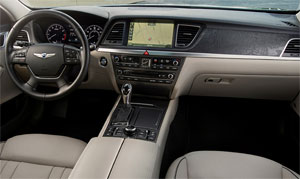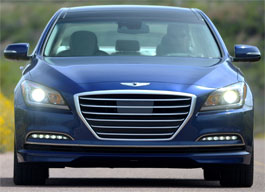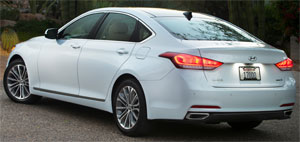2015 Hyundai Genesis
Hyundai’s path from replaceable econobox to highly desirable automotive brand has been a quick one. But, the track of their Genesis sedan from import-premium pretender to notable contender took an even faster pace. And, this 2nd generation of Hyundai’s new beginning appears to be the real deal. So, should established luxury-sports carmakers be worried? Let’s find out.
Hyundai’s Equus may be the brand’s posh flagship. But, it’s the 2015 Genesis that is the most important car for this brand and its efforts to expand into luxury sedan territory, especially if they ever hope to be a notable challenger to Audi, BMW, Mercedes, and other top-tier luxury marques.
That’s because the Genesis is not just a middle weight luxury car, it’s one that Hyundai has infused with enough sportiness to actually make us eager to hop in and drive it. And, when you do, you’ll find some of the seriously good interior quality that is required to be world class. It’s not all there yet, but it’s close. Hyundai has done a fine job of upping the “classy” with genuine materials such as great looking satin finish wood.
 Also to play in this class, it takes the latest in high tech. Updates such as Smart Cruise Control and a Head-Up Display are in line with its competition, while available safety systems like lane keep assist and Sensory Surround have the Genesis bordering on being a self-driving car.
Also to play in this class, it takes the latest in high tech. Updates such as Smart Cruise Control and a Head-Up Display are in line with its competition, while available safety systems like lane keep assist and Sensory Surround have the Genesis bordering on being a self-driving car.
The hands free trunk release is pretty trick. Just stand by the trunk with the key on you for 3-seconds and the lid pops open. Virtual gauges are bold and direct while the general dash layout is very nice.
The driver’s seating position is great, with lots of adjustments and good bolstering, though some found the wide cushions a little on the hard side. The back seat borders on huge, with lots of room to spread out, even for adults.
To be a true luxury contender you also need something else, a “big” grille! The Genesis’s has one even if it is Audi-like. And, in similar fashion, this face will also soon work its way through the rest of the Hyundai brand.
Fractionally longer in overall length, yet with 3-inches more wheelbase, proportions are now more modern. It is without a doubt more upscale, and the longer arching roofline gives Genesis a far more aerodynamic profile. In the rear, panels are more rounded as well; and the jewel-like LED tail lights are mounted high.
 The same 5.0-liter V8 and 3.8-liter V6 engines are available, but both have been revised for smoother operation and better torque delivery. Our tester sported the 311–horsepower V6 and its 293 lb-ft. of torque. The V6 is available with a new HTRAC all-wheel-drive system that works with Intelligent Drive Mode select to divert power forward or rearward depending on wheel slip.
The same 5.0-liter V8 and 3.8-liter V6 engines are available, but both have been revised for smoother operation and better torque delivery. Our tester sported the 311–horsepower V6 and its 293 lb-ft. of torque. The V6 is available with a new HTRAC all-wheel-drive system that works with Intelligent Drive Mode select to divert power forward or rearward depending on wheel slip.
But, all this means less if the makeover de elegance doesn’t carry over to the driving experience. Well, it does, but also to a point. Ride quality is very close to the Big-3 German luxury cars, even if the sporty feel still comes up a tad short.
Things have gotten more responsive and perhaps a little more settled, but when driven aggressively there’s still plenty of roll; nothing a proper ride-and-handling package wouldn’t fix. The V6 engine sounds great, but launching torque is still low, taking our Genesis to 60 in 7.2-seconds.
Response improves markedly as RPMs climb and shifts from the 8-speed automatic transmission are quick yet smooth, making the trip through the quarter mile in 15.4–seconds at 96 miles-per-hour.
Through the cones, steering feel was numb; like most of the Germans; but on the plus side, this rear-driver still retains some of the first gen car’s tossable nature even with its big improvement in smoothness. Braking is not too shabby either, with stops from 60 averaging a short 120–feet.
 The original Genesis sedan surprised us in Biblical proportions. Not just with its luxury feel, but by the fact that we liked driving it a lot. It got Genesis off to a good start and we’ve loved every namesake sedan and coupe we’ve driven since, including this car.
The original Genesis sedan surprised us in Biblical proportions. Not just with its luxury feel, but by the fact that we liked driving it a lot. It got Genesis off to a good start and we’ve loved every namesake sedan and coupe we’ve driven since, including this car.
For which government Fuel Economy Ratings are 18-City, 29-Highway, and 22–Combined. Our 23.4 mile-per-gallon average of Regular was a good one. Though the Energy Impact Score remains average, at 15.0-barrels of oil burned and 6.8 tons of CO2 emitted yearly.
And, as nice as the Genesis has gotten, it’s still a great value proposition. The “more for less-ness” starts at $38,950. Most of its direct competition, with far better name cache, start around $50,000.
Genesis signifies birth. And, while the original 2009 Genesis sedan was certainly that, it’s this 2015 Hyundai Genesis 4-door that has the potential of being a brand changing vehicle, if they can follow up with additional models in the same vein. Then, established luxury makers will have something to worry about. Not so much about losing their current customers, but about attracting future ones.
Specifications
- Engine: 3.8 liter
- Horsepower: 311
- Torque: 293 lb-ft.
- 0-60 mph: 7.2 seconds
- 1/4 mile: 15.4 seconds @ 96 mph
- EPA: 18 mpg city/ 29 mpg highway
- Energy Impact: 15.0 barrels of oil/yr
- CO2 Emissions: 6.8 tons/yr
2025 Volkswagen ID. Buzz
Volkswagen Brings Beetlemania Level Of Excitement To Minivan Segment
The duty of upholding Volkswagen’s heritage has most recently been delegated to small legacy car names like Golf and Jetta. But hold on! A much larger, totally modern take on VW’s classic microbus has just buzzed over the horizon— the all-electric ID. Buzz. It’s been at the top of our minds since we first saw the concept back in 2017. Well, it’s finally here, so let’s get our groove into drive!
This 2025 Volkswagen ID. Buzz has indeed created the most buzz around Volkswagen since the Beetle’s return to the U.S. in the late 1990s. We couldn’t drive it anywhere without drawing a crowd. No wonder, just about everyone has a VW Microbus story to tell, and seeing this reimagined version rolling down the street brings back all those memories.
VW really pulled it off as far as we’re concerned, as it looks great without appearing over the top. All the cues are here: Big VW logo front and center, lots of greenhouse including A-pillar windows and mini sliders for the second-row passengers, D-pillar air vents, and two-tone wheels. And while its appearance may be pure retro, its drivetrain is far from it, as the ID. Buzz is all-electric, and unlike the new Beetle, the Buzz does retain the original Microbus’ rear-drive architecture.
Powering those rear wheels is a 210-kW motor drawing juice from a 91-kWh battery for a range of 234 miles; 200-kW max charging will get you to 80% in about 26 minutes. Buyers can add another small 80-kW motor up front for 4motion all-wheel-drive and an increase of total output from 282 to 335 horsepower with a combined 512 lb-ft of torque. It uses the same battery, but range estimates drop just slightly to 231 miles. But while those numbers are modest, we also found them to be quite conservative, as we observed as many as 287 miles available in our all-wheel-drive tester’s gauge display and were on pace for 273 miles in our driving loop.
One throwback theme that may be a turnoff to some is that it’s quite a step up into the Buzz’s front seats, but there’s certainly a commanding view of the road once you climb in. Second row seating can be either a three-place bench or a pair of captain’s chairs, so there’s generous room for seven or six passengers. The captain’s chairs in our Pro S Plus offer good support and very easy access to the third row.
Lots of flexibility too with the option to simply fold the seats or remove them altogether.
With the sliding side doors and a wide opening rear hatch, there’s plenty of access for loading big sport utility amounts of cargo. Lots of flexibility too with the option to simply fold the seats or remove them altogether, and the ability to create a full-length flat floor with a rear cargo shelf that covers some handy removable storage bins. There’s 18.6 cubic-feet of space behind the third row, 75.5 behind the second, and a max of 145.5. That’s more than a Chevrolet Tahoe. For smaller items, there are lots of cubbies throughout the cabin, along with a standard Buzz Box that can be moved to multiple locations.
With a design that prioritizes retro form and modern function over aero efficiency, the 4motion equipped ID. Buzz earns a Fair efficiency rating, using 42-kWh of electricity per 100 miles, and we weren’t sure what to expect at our Mason Dixon test track.
What we found was great torque off the line and drama free launches to 60 in just 5.3 seconds. It was very stable at speed and power delivery stayed steady most of the way down the track until we reached about 90 mph, when it began to taper off just before we finished the quarter-mile in 14.0 seconds flat at 97 mph.
With 1,200-lbs. of battery weight nestled in its 127.5-inch wheelbase, the Buzz felt planted to the pavement through our handling course. There was quite a bit of body roll to deal with, but surprisingly little understeer. In panic braking runs, pedal response was inconsistent, feeling soft at times, pushing back hard at others; but through it all, results were quite good, stopping from 60 in an average of just 108 feet.
Three interior themes are available, this Dune is the brightest, featuring coastal inspired wood optic dash décor, “gray and clay” leatherette surfaces, and a high-mounted central 12.9-inch touchscreen. Pricing starts with a rear-wheel-drive Pro S at $61,545; this Pro S Plus begins at $65,045, add another $4,500 for 4motion, which brings a few extra features along with all-wheel drive.
Retro design with old-school VW charm, modern EV drivetrain, big SUV capacity merged with minivan flexibility; it all comes together in this 2025 Volkswagen ID. Buzz. It’s easily one of the coolest rides of the year and one that will likely keep Volkswagen dealers buzzing for years to come, and that’s something no other people and things mover can say.
Specifications
As Tested
- Motor Setup: Dual-Motor AWD
- Battery Size: 91-kWh
- Horsepower: 335
- Torque: 512 lb-ft
- EPA Range: 231 miles
- 0-60 mph: 5.3 seconds
- 1/4 Mile: 14.0 seconds at 97 mph
- Braking, 60-0: 108 feet
- MW Test Loop: ~ 273 miles













































